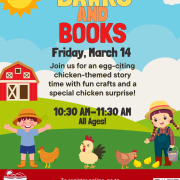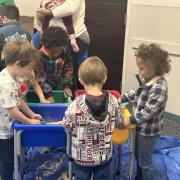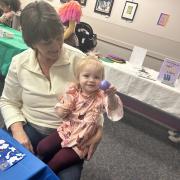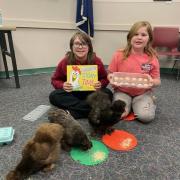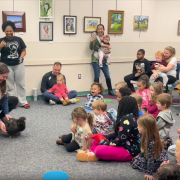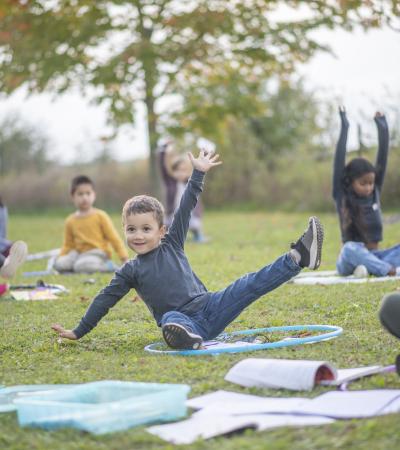I hosted a lively program where two frequent attendees brought in their chickens for a special reading of Chicken Story Time by Sandy Asher. We danced, shook shaky eggs and wrapped up with fun activities, including a sensory bin, chicken-themed crafts and a DIY shakey egg to take home.
Advanced Planning
My goal was to create a fun and interactive storytime that offered kids a unique experience. Planning began at the end of January with securing the chickens for the event date, and from there, I coordinated the activities and logistics.
With the help of my department supervisor, Shannon, several teen volunteers, three chickens, and their owners, everything came together smoothly. The biggest challenge was the time-consuming setup, but despite that, the program was a huge success, giving kids an exciting and memorable experience!
Marketing
We promoted the event through multiple channels, including our monthly calendar distributed by Youth Services, flyers posted throughout the library in early March and a Facebook post and featured calendar listing around the same time. Based on those who registered and opted to respond to the question "How did you hear about this?", many attendees heard about it through our website (10), library flyers (13), and social media (9), highlighting the effectiveness of Facebook and our website for outreach.
The event filled up quickly, so our promotional efforts were successful overall! It was always a hoot when a patron grabbed a calendar, did a double-take, and gave us a puzzled look. "Chicken Story Time? What’s that? …Wait, are there going to be actual chickens?" soon became a common question.
Budgeting
Our only expense for the program was a $12 50lb bag of cracked corn from Tractor Supply. Thanks to our habit of hoarding materials, we sourced all craft supplies from our existing stash, including donated plastic eggs, leftover lentils and beans from sensory bins, ever-present stickers and surplus popcorn kernels.
For cost-cutting, if, for some strange reason, you don't have a stockpile of hundreds of Easter eggs, I’d recommend swapping them out for a different chicken-themed craft. Local farm stores might be willing to donate a bag of corn for free, so you can also go that route.
Day-of-event Activity
We were lucky that nobody had booked our community room the previous day, which allowed us to start setup the day before. It took about two hours to gather supplies and arrange tables. Additional prep included an hour of cutting out circles for eyes and beaks for a craft and another hour assembling our new sensory table for the first time. The morning of the event, we filled the sensory bin with cracked corn and farm animals, set up craft supplies, and arranged chairs—everything went smoothly with no unexpected challenges!
Program Execution
The program unfolded beautifully, starting with the covert arrival of the chickens at 10:15, hidden behind a giant whiteboard in our kitchenette. After welcoming everyone at 10:30, we jumped right into music, skipping our usual welcome song to pass out shaky eggs and singing I Know a Chicken by Laurie Berkner, followed by an enthusiastic round of the Chicken Dance.
The chickens occasionally clucked from the kitchen, but there was so much going on that no child ever questioned sounds. We used a quick, chicken-themed rhyme—similar to Teddy Bear, Teddy Bear, Turn Around—to help the kids settle down and find their seats. Then, my department supervisor, Shannon, began reading Chicken Story Time—and that’s when the real fun began!
For those who haven’t read the story, it follows a growing flock of chickens attending a library storytime and creating chaos. To bring the book to life, I first tossed a chicken puppet onto the table behind Shannon. When the next group of chickens appeared in the story, I introduced a real one carried by its owner. As the final round of chickens arrived in the book, the last two made their grand entrance, and the story shortly ended.
Afterward, attendees could explore the sensory bin, start crafts, or observe the chickens (but not touch them, to keep them safe). Our crafts included turning painted handprints into chickens pecking at glued-on popcorn kernels, scribbling a big colorful circle with crayons and adding a beak, eyes, and a comb to create a chicken, and decorating Easter eggs with stickers, filling them with lentils and beans, and sealing them shut with hot glue to make shaker eggs.
We had a fantastic turnout—50 kids and 45 adults—who gave overwhelmingly positive feedback, with many thrilled reactions and even one little boy generously offering cracked corn from the sensory bin as a snack for the chickens. The only hiccup was a bottleneck at the hot glue station, as we only had one glue gun running to seal the shaky eggs, making the process slower than expected. The actual storytime took around 25 minutes, and they had 35 minutes to craft or play. Overall, the event was a huge success, full of laughter, surprises, and a truly memorable storytime experience!
Advice
My advice would be to give yourself plenty of time to prep crafts and set up ahead of time so you're not rushing or stressed the morning of. If your program involves making something like shaker eggs, recruit extra volunteers armed with glue guns to speed up the process. Most importantly, be ready for chaos (especially if live animals are involved) and embrace the fun—because the kids will absolutely love it!

